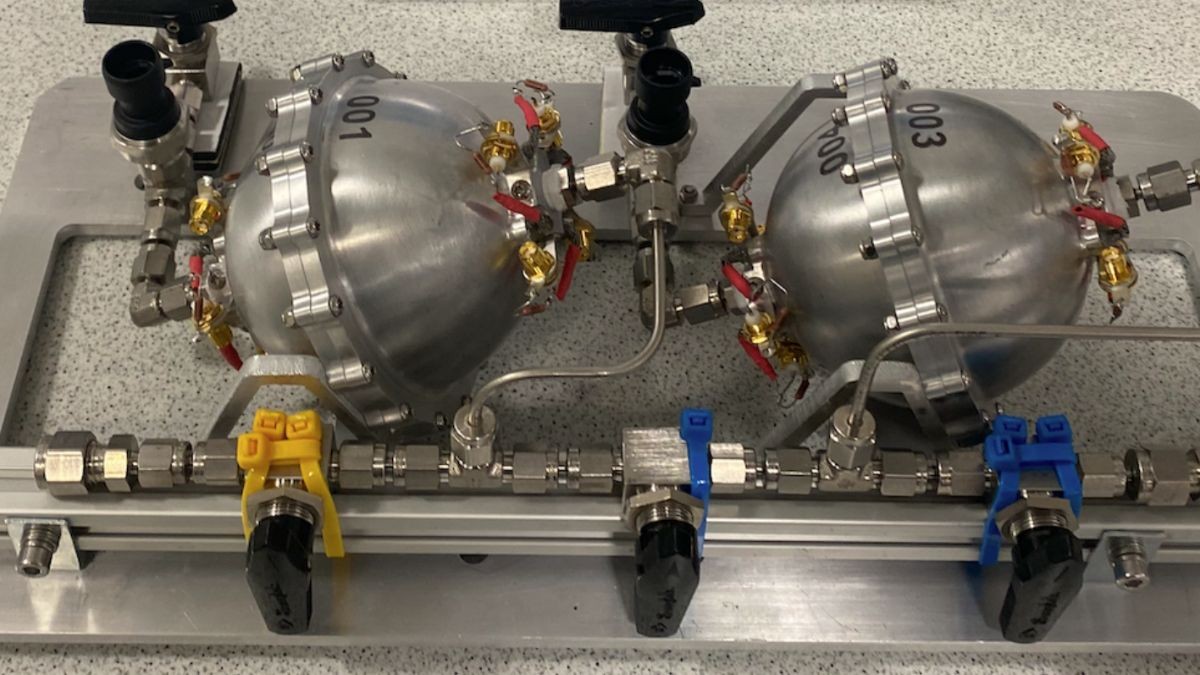Smart Tanks for Space answer the long unsolved problem of gauging propellant in microgravity
Making the most of the UK Space Agency-funded SpaceCraft programme at the University of Surrey, Atout is developing a novel ‘Smart Tank for Space’ (SMARTTS) which can report, in real-time, accurate measurements of fuel, even in space.
SMARTTS measures and reports:
- the mass of its own fluid contents
- the distribution of the contents
- how the fluid is moving, and
- the size and direction of the forces exported to the tank structure due to the movement.
The patented SMARTTS technology works in any gravity conditions and is well suited to solving real challenges in spacecraft design and operation.

Earth’s gravity allows established ways of using a level gauge to measure the liquid contents of a tank, for example a car’s fuel tank. Because level gauges do not work in zero gravity, alternative techniques are used in space. However, errors can accumulate and none of these is reliable in real-time, so people designing missions ensure there are extra reserves of fuels, with significant associated costs, not least because of heavier launches.
Atout’s SMARTTS, built at Surrey Space Centre, part of the University of Surrey, will solve this problem. The technology is inherently safe, does not introduce heat to the fluid being measured, and requires low power.
The underlying technology in SMARTTS is Electrical Capacitance Tomography (ECT). ECT sensors comprise an array of electrodes mounted around the fluid container of interest. Every possible pair of capacitance values is measured simultaneously at high frequency. Using knowledge of the sensor and container geometry and properties, these data are used to generate 2D or 3D images representing a slice or section of the fluid distribution and density. From these images the mass of propellant in the tank, centre of mass and slosh forces being exerted by the fluid on the tank can all be calculated.
Established in 2010, Atout has established a growing, profitable business with an innovative portfolio of technologies applied to a number of diverse industries. The technology portfolio includes a range of non-intrusive electromagnetic measurements such as Electrical Capacitance Tomography (ECT), Magnetic Inductance Tomography (MIT), Electrical Velocity Tomography (EVT), and other novel techniques. Atout deploys these novel techniques to some of the most difficult measurement problems in industry including food, energy, oil and gas, aerospace and defence, seeing inside pipes, vessels, through opaque barriers and weighing without touching.
Richard Foster-Turner, Chief Operating Officer, Atout Process Ltd, said:
“Without the facilities we’ve had access to at Surrey Space Centre, our Smart Tanks for Space wouldn’t get off the ground – if you’ll pardon the pun. It’s not enough to have a good idea; you also need a way to demonstrate it works and turn it into reality. The facilities and people at Surrey Space Centre have been exactly what we needed – it’s fantastic having everything we need right there, along with expert advice from specialists who really understand the space sector.”
Actions taken with Surrey Space Centre:
Thanks to the SpaceCraft programme, Atout used the assembly area at Surrey Space Centre to build their prototype SMARTTS. They also needed support and advice from knowledgeable people with a background in the space industry, and the experts at Surrey Space Centre were able to help.
When they build SMARTTS for the flight phase of their testing, they will need many of Surrey Space Centre’s specialist facilities, including the large clean room, environmental test facilities, and the vibration testing facility which simulates the stresses exerted during launch.
Outcome/impact:
Atout has already demonstrated real-time, low-cost, mass measurement of tank contents, independent of gravity conditions, to better than 1% accuracy.
SMARTTS technology answers the long unsolved problem of gauging propellant in microgravity. SMARTTS is applicable to any space vessel using liquid or gaseous propellant, at any scale, and as such has enormous potential to be adopted in everything from CubeSats to Superheavy launchers. Accurate propellant mass measurement will enable extended life for satellites, and accurate slosh force measurement will enable improved control of spacecraft manoeuvres, while accurate in-flight propellant transfer where each party has exact knowledge of the amount transferred will be critical for extended manned spaceflight.
The future:
Development of SMARTTS for multiple applications is ongoing, notably via several projects in collaboration with several commercial and space agency partners, and an In Orbit Demonstration mission in collaboration with the European Space Agency (ESA), expected to launch in 2025. They will build SMARTTS using Surrey Space Centre’s facilities, the only viable way given their longer-term business model which relies on licensing their technology to specialist organisations.
For more information about Atout, contact enquiries@atoutprocess.com